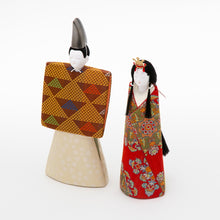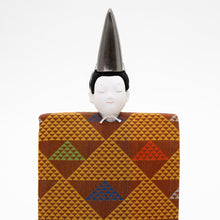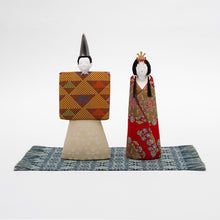Description
Mokumekomi (dolls) are made by digging grooves in the body, which is made of hardened paulownia wood powder kneaded with glue, and then inserting fabric into the grooves to dress the doll.
The carefully selected fabrics include 41 colorful types, such as sakiori with gold and silver threads woven into them, unique weaving patterns such as bulge weave, and sakiori using special weaving techniques.
The work is also made using traditional techniques that have been passed down through the generations, with a focus on expressing the solemnity and dynamism of the sacred "dragon".
Patterns
※使用生地をご紹介(当商品は複数の文様を使用しています。)
"Rikyu" Brocade
The original cloth which was one of the favorites of Rikyu, a great tea master, is a brocade with plum blossom motifs in yellowish brown which softly melt into a light blue background. This design is a superb one to represent plumblossoms with five dots in yellowish brown and a lineal construction to combine these dots. In view of its wide use today, we introduced a slight change to the texture of the original fabric.
For a color scheme we learnt the way of making and sense of the original, and tried to represent plum-blossoms in various background colors and by the shades which harmonize with these colors.
NISHIKI

There are two ways of expressing "nishiki" in a Chinese character. According to a dictionary, it is said that the character "nishiki" was made by laying two characters "kin" and "kinu" (which mean gold and silk) side by side, for patterns for nishiki are woven with variously colored silk threads and the price is very expensive like gold.
Nishiki can be roughly classified into two kinds - "keikin" and "ikin". In the former the background color and the patterns are effected by colored warps, and in the latter effected by colored wefts. These nishiki were already used as the coats for noble men in the Chou Period (B.C12-3Century) in China, and since then they have been admired by people as a gorgeous and expensive fabric.In Japan some records for nishiki can be seen in such old books as Kojiki and Nippon Shoki.
Throughout intervening centuries nishiki has been used for costumes, sash materials, mounting, altar cloths, surplices and Noh costumes.
The kinds of nishiki are so many today, however, and nishiki becomes a popular name for all silk fabrics of which exquisite patterns are woven by using wefts of various materials including threads and leaves in gold and silver.
Uroko Gondayū Mon(Warp-patterned Brocade)
A simple geometric pattern composed of regular triangles in continuation is called "Uroko Mon" (scale pattern),which symbolizes the snak e and has been highly regarded by people as a charm against the devil and ill luck.
The basic design of this piece is adopted from the "Gonday ū Kinran", a gold brocade which is counted among the "Meibutsu-gire (celeb rated textiles imported from abroad, mainly China, in the 14th-18th centuries, closely connected with tea ceremony). The original fabric was n amed after Gondayū Chōandō, a local governor in Nara and its proud owner.
With our original pattern composition and colour scheme a very colourful warp-patterned brocade has been executed.
























































